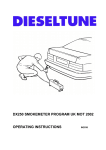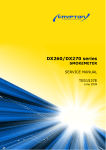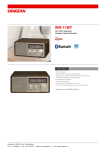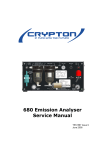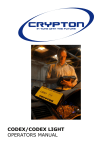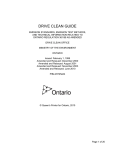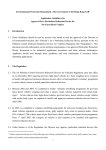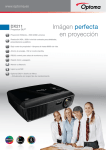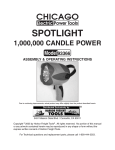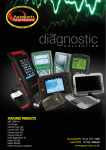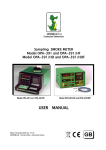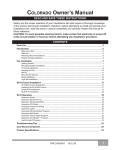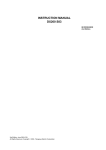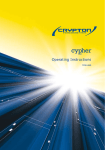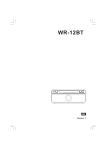Download SMOKEMETER DX260/DX260BT OPERATORS MANUAL
Transcript
SMOKEMETER DX260/DX260BT (Also covering STP620-EN540) OPERATORS MANUAL IN2044/L Oct 2005 DX260/DX260BT HARDWARE OPERATORS MANUAL Page 2 DX260/DX260BT SMOKEMETER SPECIFICATION Dieseltune has a programme of continued product development and therefore reserves the right to amend product specifications without prior notice. While every effort is made to ensure the accuracy of the particulars contained in this instruction book, the Manufacturers and the Authors shall not in any circumstances be held liable for any inaccuracy or the consequences thereof. E. & O. E. COPYRIGHT © Foldcrown Limited 2003 All rights reserved. No part of this publication may be reproduced, stored in a retrieval system, or transmitted in any form, electronic, mechanical, photocopying, recording or other means without prior permission in writing from Foldcrown Ltd. PATENTS These products are covered by one or more of the following Patents or Patent applications: GB - 2257515, 2268805. EU - 0521725, 0650586. US - 5353629, 5596155 DX260/DX260BT HARDWARE OPERATORS MANUAL Page 3 CONTENTS Page INTRODUCTION Regulatory notice………………………………………………………… General description ……………………………………………………… Smoke measurement questions and answers………………………… 4 5 7 CONNECTIONS…………………………………………………………………... Keyboard & Mouse……………………………………………………….. Monitor……………………………………………………………………... Smokehead………………………………………………………………... Temperature Probe & Tacho…………………………………………….. Remote Handset…………………………………………………………... 9 9 11 12 12 13 OPERATION………………………………………………………………………. Outdoor testing……………………………………………………………. Sampling head and pipes………………………………………………... Engine speed adapters…………………………………………………... Oil temperature probes…………………………………………………… Remote Indicator Handset……………………………………………….. Warm-up…………………………………………………………………… Wireless Smokemeter Operation (DX260BT only)…………………… Battery Charging (DX260BT)…………………………………………… 14 14 14 17 20 21 23 23 24 OPERATING SYSTEM………………………………………………………….. Programme Update………………………………………………………. 26 28 MAINTENANCE…………………………………………………………………... Serial numbers……………………………………………………………. Cleaning sampling pipes………………………………………………… Calibration…………………………………………………………………. Lens cleaning……………………………………………………………… Sampling head cable renewal (DX260 only)…………………………… 29 29 29 29 30 31 CONSUMABLE SPARES ……………………………………………………….. 32 OPTIONAL EQUIPMENT …….……………………….………………………… 33 SPECIFICATION………………………………………………………………….. 34 SERVICE CONTACT.......……………………………………………………….. 36 NOTE: This manual only describes the Smokemeter hardware. For details of software controlled procedures, refer to the appropriate software manual IN2043. DX260/DX260BT HARDWARE OPERATORS MANUAL Page 4 REGULATORY NOTICES EUROPEAN This equipment complies with the essential requirements of the following European Directives: Directive Applied Standard EMC 89/336/EEC (Electromagnetic Compatibility) EN50081-1 EN50082-1 Generic Emissions Generic Immunity LVD 73/23/EEC (Low Voltage) EN61 01 0-1 Electrical Safety Regs. 1994 USA AND CANADA FCC Rules This equipment has been tested and found to comply with the limits for a Class A digital device, pursuant to part 15 of the FCC Rules. These limits are designed to provide reasonable protection against harmful interference when the equipment is operated in a commercial environment. This equipment generates, uses and can radiate radio frequency energy and, if not installed in accordance with the instructions of the manual, may cause harmful interference to radio communications. Operation of this equipment in a residential area is likely to cause harmful interference in which case the user will be requested to correct the interference at his own expense. To maintain compliance with FCC Rules the user must: a. Not make any modifications to the equipment without authorisation from the manufacturer. b. Use only genuine accessories. UL Mark This equipment carries the UL Mark for Canada and the United States. The user must be aware of the following warnings. IMPORTANT SAFETY INSTRUCTIONS • • • • • • • • • • Read all instructions. Care should be taken as burns can occur from touching hot parts. Do not operate equipment with a damaged cord or if the equipment has been dropped or damaged until it has been examined by a qualified serviceman. Do not let cords hang over edge of table, bench or counter or come in contact with hot manifolds or moving fan blades. If an extension cord is necessary, a cord with a current rating equal to or more than that of the equipment should be used. Cords rated for less current than the equipment may overheat. Care should be taken to arrange the cord so that it will not be tripped over or pulled. Always unplug equipment from electrical outlet when not in use. Never use the cord to pull the plug from the outlet. Grasp plug and pull to disconnect. Let equipment cool completely before putting away. Loop cord loosely around equipment when storing. To reduce the risk of fire, do not operate equipment in the vicinity of open containers of flammable liquids (gasoline). Adequate ventilation should be provided when working on operating internal combustion engines. To reduce the risk of electric shock, do not use on wet surfaces or expose to rain. Use only as described in this manual. Use only manufacturers recommended attachments. SAVE THESE INSTRUCTIONS DX260/DX260BT HARDWARE OPERATORS MANUAL Page 5 INTRODUCTION GENERAL DESCRIPTION The DX260/DX260BT Smokemeter is a partial flow opacimeter suitable for Free Acceleration and Full Load testing of all sizes and types of diesel vehicles. It consists of two main items, a smoke sampling head and an interface unit. The DX260BT is a wireless (Bluetooth®) variant. Schematic diagram of smoke sampling head 1 2 3 4 5 Smoke inlet Heater Bypass Photo diode Purge air 6 7 8 9 Fan Green LED Temperature Sensor Measuring tube The smoke sampling head operates at low voltage (24V DC for DX260-1 Smokehead, 30v DC for DX260-1BT Smokehead), and is suitable for use in all weather conditions and at temperatures down to -15ºC. It consists of a green LED and a photodiode mounted at opposite ends of a measuring tube, such that the effective light path length through the smoke is 250 mm. The measuring tube and the LED / Photodiode assemblies are heated such that their minimum temperature is 70ºC, thereby preventing condensation of the oil and water content of the smoke. The temperature of the smoke is measured at the inlet to the measuring tube so that, if necessary, an automatic correction can be applied to the opacity readings for smoke temperatures other than 100ºC. The smoke sampling head contains a fan to draw the smoke sample into the measuring tube via a by-pass system, so that the pressure inside the tube cannot normally exceed ambient by more than 7.5 mbar. This provides for rapid response and fast clearance of the smoke sample after testing. DX260/DX260BT HARDWARE OPERATORS MANUAL Page 6 The lenses are protected by an air curtain which reduces sooting. In addition, the sampling head has an autorange feature which can provide a step change in LED intensity to compensate for dirtiness. The measuring tube contains rings to eliminate reflection, and the LED is pulsed so that the detection system can ignore any ambient light level. Mid-point calibration is provided by automatically interrupting this pulse train to provide (for example) 3 pulses out of 8 to give a calibrated light level of 3/8 or 37.5% (patented). Sampling pipes are available to suit most exhaust systems including mid-chassis and vertical. Extension poles are available for very high vertical exhausts. The interface unit is connected to the sampling head by a single cable of up to 20m in length (DX260) or via cableless (Bluetooth®) communications (DX260BT). The cable carries power to the head and data in both directions, for the cableless system the smokehead derives its power from internal rechargeable batteries. All information is sent to the host computer via a single RS232 link. This link also carries the control commands from the computer to the Smokemeter system. Readings of RPM and oil temperature are routed to the computer from other peripherals, typically a Petrol EGA or from the DX211-12 RPM Adapter or via a cableless (Bluetooth®) comms system. The host computer controls the test sequence, and carries out all processing of the test results. Depending on national requirements, various tamperproof security systems may be included, ranging from self adhesive labels to special screws to take a wire seal. In addition, the sampling head has its serial number stored in permanent memory and the sampling head contains a clock that provides information for the printout and also to control the calibration interval. Important: Please note that some models will utilize BLUETOOTH® technology. Whilst the radio modules used have a designed maximum range of 100m in free space conditions, the actual reliable working range achieved will depend on the conditions prevalent at the time and location of use, therefore no guarantee or warranty of usable working range is given or implied. BLUETOOTH® is a registered trademark of Bluetooth SIG Inc. and is used by Crypton Technology Group under licence. DX260/DX260BT HARDWARE OPERATORS MANUAL Page 7 SMOKE MEASUREMENT QUESTIONS AND ANSWERS Q) Why is only diesel smoke measured when petrol engines normally have an emissions test ? A) It is more difficult and much more expensive to measure diesel emissions. This is because carbon monoxide levels are much lower; the hydrocarbon content cannot be measured by the normal infra-red technique and for reliable results a chassis dynamometer is desirable. Q) What are Particulates ? A) The particulate part of a vehicle exhaust is any substance present as a liquid or solid (i.e. not a gas). For a diesel, carbon forms at least half the particulate content, the remainder being made up of hydrocarbons (e.g. unburnt fuel droplets and lubricating oil), sulphates (from the diesel fuel's sulphur content) and water. Q) What is an Opacimeter ? A) A Smokemeter working on the principle of shining a light beam through the exhaust smoke to determine its 'density' or 'opacity'. Q) What is a partial flow system '? A) The three opacimeter systems are as follows: FULL FLOW. The light beam shines through the exhaust smoke as it flows through a specially adapted tailpipe. Potentially it is an accurate system, because the measurement is taken across the entire exhaust flow. However, high temperatures can be encountered and specially adapted exhaust systems are required. FREE FLOW. The light beam shines through the exhaust smoke as it comes out of the tailpipe. It is relatively easy to fit, but the accuracy of the readings is severely affected by variations in exhaust plume diameter. PARTIAL FLOW. A sample of the smoke is taken from the tailpipe for analysis in a separate chamber. It is easy to fit to a wide range of tailpipe sizes, but care must be taken to achieve a representative sample of smoke in the measuring chamber. Most smokemeters for testing vehicles in service use the partial flow system. DX260/DX260BT HARDWARE OPERATORS MANUAL Page 8 Q) Why are there so many different smoke measurement scales ? A) Some scales relate to measurements by methods different to the opacimeter system, for example the Filter Smoke Number (sometimes known as the Bosch Smoke Number). The other scales are because not all opacimeters use the same path length. As the path length is increased, the amount of light obscured by a given density of smoke will also increase. Opacimeters normally calculate their answer on a percentage scale; clean air is taken to be 0%, and totally black smoke is called 100%. But this percentage scale will be different for every opacimeter having a different light path length. It is normal therefore for the answer to be given in k, the 'coefficient of light absorption' where: k = -1 L Where and loge 1 - N 100 N = the percentage of light obscuration L = light path length in metres k has the units 'per metre', usually written as 1/m or m-1 or m-1 Q) What is pressure and temperature compensation ? A) Diesel exhaust smoke is made up of lots of tiny particles of carbon. If pressure is applied to the smoke it will be compressed and the carbon particles made to occupy a smaller space, thereby making the smoke appear denser. Similarly, if the temperature is increased the smoke will expand and appear less dense. It is important therefore that either the pressure and temperature are carefully controlled, or alternatively they are measured and a correction factor is applied to the smoke value obtained. 0) What does 'Response Time' mean ? A) When operating under free acceleration conditions, the speed at which a smokemeter reacts is the key to the answer obtained. The 'puff' of smoke caused by increasing an engine momentarily to maximum speed is of very short duration, but it takes time for this 'puff' to find its way down the sample pipe and into the smokemeter, and this can cause 'damping' of the result. After that, the speed at which the meter can measure the smoke inside it will also affect the answer obtained. It is essential therefore that all smokemeters have a defined 'Response Time', and normally this is specified in national legislation, e.g. EEC directive 72 306, SAE J1667 etc. DX260/DX260BT HARDWARE OPERATORS MANUAL Page 9 CONNECTIONS FITTING THE KEYBOARD AND MOUSE To fit the Keyboard, Mouse and Monitor follow the procedure detailed below, observing the correct sequence of actions: 1. Remove the back panel as shown in Fig. 1 by unscrewing the 4 earth nib Philips screws. The panel is connected to the main trolley by an earth bonding wire; take care not to strain or damage the lead while the back panel is removed. Note the plastic grommet for the monitor cables, this will need to be removed later when fitting the monitor. Note plastic grommet for monitor cables Unscrew the four earth nib screws and remove the back panel Fig. 1 2. Place the keyboard and Mouse on the front tray of the trolley (Fig. 2). Feed the cables through the hole at the back of the tray, over the top of the Computer and plug in to the colour coded connectors on the back of the computer, green for the mouse and purple for the Keyboard. Refer to Fig. 3 DX260/DX260BT HARDWARE OPERATORS MANUAL Page 10 Feed cables through hole at rear of tray Fig. 2 Route cables over top of Computer Mouse Connector (green) Plug monitor into ‘D’ type connector Keyboard Connector (purple) Fig. 3 DX260/DX260BT HARDWARE OPERATORS MANUAL Page 11 FITTING THE MONITOR 3. Slacken the four screws (do not remove) securing the Monitor clamp to the top of the trolley. Fit the Monitor base to the Monitor and place on top of the trolley at the back with the screen facing the front. Slide into position underneath the clamp and retighten the four screws as shown in Fig. 4a. The Transit Bracket must then be secured to the rear of the monitor as shown in Fig. 4b Place Monitor on back of trolley and slide forward underneath retaining clamp. Slacken screws and retighten when monitor is in place. Clip Transit Bracket to rear of Monitor and secure to trolley with its retaining screws. Transit Bracket Fig. 4a Fig. 4b If supplied with an LCD monitor then remove and discard the monitor retaining clamp and re-use fixing screws to secure the metal LCD stand in position. Unpack the LCD and discard the LCD stand supplied with the screen. Offer up the LCD monitor to the metal stand and secure with screws supplied. Fit the monitor signal lead, adjust tilt of screen as required and tighten in position. A Transit Bracket is not required. 4. Remove the plastic grommet from the hole in the trolley immediately behind the Monitor (Fig. 1). Feed the monitor signal lead through the grommet from the top and then down through the hole in the metalwork. The monitor mains lead is already fitted and the free end will be lying with the computer. Feed this up through the metalwork and then through the grommet from the bottom. Replace the grommet. 5. Plug the mains lead into the socket on the back of the Monitor and the signal lead into the 15 way high density ‘D’ type connector on the computer as shown in Fig. 3 Tighten the screw locks finger tight. Ensure that there is enough slack left on the cables to allow the Monitor to swivel from side to side. 6. Bundle cables neatly into the rear of the unit and replace the back panel, taking care not to trap or damage the earth lead. FITTING THE CABLE HOOKS Four hooks are provided for securing cables. Threaded inserts are fitted just below the ‘Crypton’ label on each side of the unit for this purpose. Fit hooks using hardware DX260/DX260BT HARDWARE OPERATORS MANUAL Page 12 SMOKEHEAD CONNECTION (DX260 - Non wireless system only): CONNECTION TO SMOKE HEAD DX211-11/DX211-11BT OIL TEMPERATURE PROBE The Oil Temperature probe holster/recharging station is located on the top panel of the unit towards the right rear. Fig 5a and 5b illustrates how a DX211-11BT wireless probe is inserted into the holster. Note the red LED indicating the unit is charging. Fig. 5a Fig. 5b Note on charging the DX211-11BT Wireless probe The DX211-11BT wireless probe is both switched off and recharged by being inserted into its holster. In order to achieve a long battery service life in this sealed unit, the recharging current is deliberately set at a low level. It is imperative that the unit be returned to the holster immediately after each use. Failure to do this will cause the probe to cease operating during the working day and it will require a continuous, uninterrupted recharging period of 48 hours to fully recover. The DX211-11 Oil Temperature probe uses the same holster with the wire connected to a socket on the back panel, shown in Fig. 6. Leave the probe permanently connected and use the hooks on the side of the equipment to stow the cable when the probe is in the holster. OIL TEMPERATURE & RPM INPUTS: RPM Adapter (DX211-12) - wired Oil Temp Adapter (DX211-11) - wired Fig 6 WARNING: For safety reasons mains supplies must always be earthed. DX260/DX260BT HARDWARE OPERATORS MANUAL Page 13 FITTING THE DX211-13 REMOTE INDICATOR HANDSET HOLDER A plastic holster is provided for the DX211-13 Handset. Threaded inserts are fitted to the left of the ‘Crypton’ label on the right hand side of the unit for this purpose. Fit the holster using hardware provided. Figure 7 shows the Handset in its holster. Fig. 7 FITTING THE DX211-12 RPM ADAPTER No special fittings are provided for the DX211-12 wired or DX211-12BT wireless RPM adapters. When not in use, it may be hung by its handle on any of the hooks provided. Fig. 6 shows the position of the data connector for the wired unit. DX211-12 Data Lead connection shown in Fig. 6 Power & Signal lead to Vehicle Battery Fig. 8 DX260/DX260BT HARDWARE OPERATORS MANUAL Page 14 OPERATION OUTDOOR TESTING If it is necessary or desirable to test a vehicle outside the workshop, the following points must be borne in mind. The sampling head is weather resistant and may be used in temperatures down to a minimum of -15ºC. WARNING: The power supply and PC are not weather protected and for the safety of both the operator and the equipment, these parts MUST be kept under cover in inclement weather conditions. SAMPLING HEAD AND PIPES Connect the cable from the sampling head to the interface unit 'SMOKE' connection. Ensure it is securely connected. Connect the appropriate sampling pipe to the sampling head. Sampling pipe DX210-4A The sampling pipe DX210-4A can be used for all vehicles, but for convenience of use alternative pipes are available. DX260/DX260BT HARDWARE OPERATORS MANUAL Page 15 (Sampling Pipes continued) Sampling pipe DX210-5C The sampling pipe DX210-5C has a remote clamp and is used to access mid-chassis exhausts on large commercial vehicles. To use, hold the sampling pipe and the sampling head as shown in the illustration with the arm rest under the forearm. The head of the pipe has a pivoting action so that the 'aim' of the pipe can be changed by moving one arm forwards or backwards relative to the other arm. Use the hand lever to operate the jaws and clamp the pipe in position, then allow the remote clamp and the sampling head to rest on the floor. Sampling pipe DX210-6 Sampling pipe DX210-6 is used for vertical exhausts. Hang the sampling pipe and the sampling head as shown in the illustration. DX260/DX260BT HARDWARE OPERATORS MANUAL Page 16 For very high exhausts, an extension Pole 1.5 m or 2 m length may be fitted to the sampling head using an Extension kit DX260-160L (1.5m) or DX260-160H (2.0m) as illustrated. Using extension pole NOTE: Before fitment of a sampling pipe, inspect its 'O' ring for damage and renew if necessary (order part number DX210-5/60). Periodically apply a smear of grease to the 'O' ring to assist fitment of the sampling pipe to the sampling head. CAUTION: The results of free acceleration testing will be affected by changes in sampling pipe diameter and / or length. Only genuine pipes must be used and their design must not be altered in any way. The smokehead body must always be positioned in clean air and away from exhaust fumes when in use. WARNING: Sampling pipes can get very hot; take care when disconnecting from the sampling head. DX260/DX260BT HARDWARE OPERATORS MANUAL Page 17 ENGINE SPEED ADAPTERS Engine speed on the DX260 can be derived via inductive clamp on a gas analyser where fitted (STP620-EN540 only). The following three types of engine speed adapter are available: CDSS2 Acoustic/Vibration sensor type For Petrol and Diesel engines 2 POWER SUPPLY INPUT (SUPPLIED) LOOP FOR INDUCTIVE PICKUP ACOUSTIC/VIBRATION SENSOR This adapter measures the noise and vibration of an engine, and converts this information to engine speed. Note: The CDSS2 is supplied with a signal interface cable to be used on products where the Engine Speed is derived via the smokehead interface box. This lead is not required on the DX260 as the Engine speed via the CDSS2 is derived via the gas analyser. Operation Attach the magnetic sensor to a part of the engine. Clip the inductive probe from the gas analyser around the loop provided on the engine speed adapter. The LED on the sensor should be RED. Start the engine and allow to idle. The LED on the sensor should change from RED to AMBER. Run the engine at a fast idle around 2000 rpm until the LED changes to green. The bar graph should read the correct speed. For further details, please refer to the instructions supplied with the adapter. DX260/DX260BT HARDWARE OPERATORS MANUAL Page 18 CDSS3 Battery sensing type for Gas Analyser input For Petrol and Diesel Engines LOOP FOR INDUCTIVE PICKUP POWER SUPPLY AND BATTERY SENSING LEADS This adapter measures the frequency modulation of the alternator across the battery terminals, and converts this information into engine speed. Used with gas analyser where fitted (STP620-EN540 only). Operation Start the engine, allow to idle and turn on the lights. Ensure all other accessories, internal blower, screen heater etc. are off. Set the correct number of cylinders on the rotary switch and attach the CDSS3 clips to the battery noting the correct polarity. Clip the inductive probe from the gas analyser around the loop provided on the engine speed adapter. BEWARE ROTATING PARTS. Allow the engine to idle while the CDSS3 initialises, approximately 17 seconds. When complete the unit will read engine speed on the bar graph. If the speed appears to be incorrect, reset the CDSS3 by disconnecting and reconnecting one of the leads. For further details, please refer to the instructions provided with the adapter. DX260/DX260BT HARDWARE OPERATORS MANUAL Page 19 DX211-12 & 211-12BT Wireless Battery sensing type for Smokemeter input. Petrol and Diesel Engines Engine speed for the DX211/DX211BT can be derived via a battery sensing tachometer –DX211-12 RPM Adapter or cable-less (Bluetooth ) RPM Adapter DX211-12BT. R DX211-12 RPM Adapter DX211-12BT RS232 Comms connector This adapter measures the frequency modulation of the alternator across the battery terminals, and converts this information into engine speed. Operation Ensure the battery clamp leads are connected to the DX211-12. Start the engine, turn on the vehicle lights, and allow engine to idle. Ensure all other vehicle accessories; internal blower, screen heater etc. are off. Attach the DX211-12 clips to the battery noting the correct polarity. When prompted by the smokemeter programme, set the correct number of cylinders of the vehicle engine. BEWARE ROTATING PARTS. Allow the engine to idle while the DX211-12/DX211-12BT initialises (this may take up to 15 seconds). When complete the unit will indicate the engine speed on the console screen. If the speed appears to be incorrect reset the DX211-12/ DX211-12BT by disconnecting and then reconnecting one of the battery leads. For further details, please refer to the instructions provided with the adapter. Battery clamp connector DX211-12BT DX260/DX260BT HARDWARE OPERATORS MANUAL Page 20 OIL TEMPERATURE PROBE The DX211-11 and DX211-11BT Temperature Probe Adapters are used in conjunction with the DX210-25A/26 oil probes for engine temperature measurements. The DX211-11 is hard-wired to the smokemeter; the DX211-11BT communicates via Bluetooth® wireless technology. DX211-11 Wired Temperature Probe Adapter DX211-11BT Wireless Temperature Probe Adapter Connection to the Smokemeter The DX211-11 utilises an RS232 communications cable for connection to the Smokemeter. The unit connects to the smokemeter via the 9-way ‘D’-type socket on the side of the unit. When not in use the flexible probe must be stored in the conduit tube at the top of the Smokemeter trolley and the DX211-11 must be supported in the bracket above the tube. It is not necessary to disconnect the two component parts when stored. The DX211-11BT is a wireless device that will communicate with a Bluetooth® Smokemeter via Bluetooth® wireless technology. A dedicated holster is fitted to the top of the trolley, which should be used to store the unit when not in use. The DX211-11BT batteries will be charging at all times whilst stored in the holster, indicated by the status indication light at the end of the unit glowing red. Oil temperature probe connections To measure oil temperature a flexible probe is plugged into the adapter (DX210-25A/26). Connect the flexible oil probe to the socket on the DX211-11/11BT. This connector includes a snap-lock feature that ensures a reliable connection between the two devices. Adjusting oil temperature probe length Before testing, the probe must be adjusted to the correct length as follows: Lay it alongside the vehicle dipstick (see illustration) and adjust the position of the depth stop until the effective length of the probe is approximately 10mm shorter than the dipstick. 10mm Flexible probe Oil dipstick WARNING: ENSURE THAT THE OIL TEMPERATURE PROBE IS SET TO THE CORRECT DIPSTICK LENGTH AND THAT IT IS CLEAN FROM DEBRIS BEFORE INSERTING INTO THE ENGINE. FAILURE TO DO SO MAY RESULT IN SERIOUS DAMAGE TO THE PROBE AND/OR ENGINE. DX260/DX260BT HARDWARE OPERATORS MANUAL Page 21 Operation of Oil Temperature Probe The DX211-11 will communicate directly with the smokemeter via the RS232 Serial communications signal cable. The DX211-11BT communicates with a suitable Bluetooth® smokemeter via Bluetooth® wireless technology and will have been set up and configured to the smokemeter equipment. Before operation of the DX211-11/11BT ensure that the oil probe length has been set correctly (see previous section) prior to deploying the probe on the vehicle. When prompted by the smoke test program remove the temperature probe assembly from the smokemeter and insert the oil probe into the dipstick. In the case of the DX21111BT, the blue status light will activate, indicating that the adapter has made the Bluetooth® connection with the smokemeter. Whilst under the engine bay do not rest any part of the DX211-11/11BT on any hot surfaces as serious damage is likely to occur to the unit. When the test is complete ensure that the probe and adapter are cleaned thoroughly and stored appropriately. REMOTE INDICATOR HANDSET (where used) The DX211-13BT communicates throttle command instructions to the vehicle tester, allowing the ability to follow the correct testing sequence without the need to be in visual range of the host display screen. The DX211-13BT communicates via the latest Bluetooth® wireless technology to the DX260BT and has a range (in free air) of approximately 100 metres. Switching on To switch on the handset, momentarily press the power button – the blue Power/ Function LED indicator will illuminate and flash Slow flash - 1 flash/second – normal Fast flash - 5 flashes/second – battery low Once communication has been established between the handset and the DX260BT the LED indicator stops flashing and remains steady on. Switching Off The handset will switch off automatically under the following conditions: Test sequence completed No communications established within 30 seconds No commands received within 5 minutes Low battery on power-up (fast flash for 3 seconds) DX260/DX260BT HARDWARE OPERATORS MANUAL Page 22 Operation of Indicator Handset Starting the test To initiate the test sequence press and hold the Power/Function button – the Power/Function LED will blink twice and the test sequence will start. Aborting the test To abort the test press the Power/Function button three times quickly (within 1 second). – the Power/Function LED will blink twice and the test sequence will abort. The test sequence Once the user has switched the handset on and initiated the test sequence (see 'Starting the test'– above) the command instructions on the handset follow the sequence determined by the test programme: - Fully depress the accelerator pedal and hold - Release the accelerator pedal and wait - Test completed – return to console Battery level warning If the battery power depletes below the required level during operation the Power/Function LED starts blinking steadily (1 blink every 2 seconds) the batteries should be recharged or replaced as soon as possible. If the battery power level has depleted on switch-on and communication has not yet been established the Power/Function LED will flash rapidly (5 flashes/ second) and the handset will automatically switch off after 3 seconds. The batteries should be recharged or replaced immediately. Note: the handset will not power down during a test sequence but the batteries should be replaced as soon as the current test has been completed. DX260/DX260BT HARDWARE OPERATORS MANUAL Page 23 WARM-UP Switch on the main On/Off switch at the side of the console unit. The ‘Power On’ warning light will illuminate. There is a warm-up time of 5 to 20 minutes dependent on the outside temperature. During this time the Smokemeter will not function. NOTE: For details of software controlled procedures, refer to the appropriate software manual. R CABLE-LESS BLUETOOTH SMOKEHEAD OPERATION (DX260-1BT) R For cable-less (Bluetooth ) systems the operation of the equipment is identical but a Bluetooth enabled Smokehead (DX260-1BT) is utilised. R When the equipment is first switched on the smokehead should be firmly positioned onto its charging base and the unit should be allowed to charge for a minimum of five to six hours (or preferably left overnight) to fully charge the batteries. The equipment screen will prompt the user to return the smokehead to its charging base between tests. This must be obeyed in order to proceed further. Failure to return the smokehead will result in depletion of the battery charge and may result in a shortened lifespan. The test will not continue until the smokehead has been returned. Blue flashing LED indicates battery charging operation Ensure the Smokehead is firmly positioned onto the charger base It is strongly advised that the Charger Cradle be left permanently switched ON with the Smokehead in situ overnight to ensure full operational usage at beginning of the working day. Please note that rechargeable batteries have a finite lifespan, therefore the battery pack will need to be replaced periodically if the smokehead is no longer sustaining sufficient charge for correct operation. Please contact a Service Engineer through Product Support. DX260/DX260BT HARDWARE OPERATORS MANUAL Page 24 R The DX260-1BT Bluetooth Smokehead contains a Multi-Cell Rechargeable Battery designed to give a maximum of 1.5 hours endurance from a full charge. To recharge, the Smokehead must be correctly located on its charging cradle. The Smokehead must always be replaced on the charging cradle in between tests. This will maximise the battery endurance and is also necessary for test results to be printed. On the handle of the Smokehead is a highly visible Blue Light emitting Diode (LED). This LED gives indication of the status of the Smokehead whether or not it is on its charging Cradle. BATTERY CHARGING Modes and Endurance: The nominal endurance of the internal Battery pack is 1.5 hours continuous use from a full charge and cold start. This will vary according to ambient temperature. For optimum useage and battery life, the smokehead should be removed from the charging cradle for the minimum amount of time and returned to the charger immediately after testing as prompted by the smoke test Software. The rate of charging is dependant on a combination of Battery Voltage and Battery Temperature. If the Smokehead has seen reasonable use the charger will switch to ‘Fast Charge’, taking approximately 1.5 hours to fully recharge. Once full terminal Voltage has been reached, the battery charging rate is reduced to ‘Trickle Charge’. When charging for a protracted period, for example overnight, a trickle charge of 15 hours will completely recharge the internal battery. A blue LED on the Handle indicates the Charging Status. LED Indication 1. Smokehead removed from Charging Cradle: LED ‘On’ continuously: Smokehead is running on internal Battery. LED pulsing ‘ON’ for 2 seconds, ‘OFF’ for 0.5 seconds: Smokehead battery has reached a Low Voltage condition, and has less than 10 minutes life left before Auto-shutdown. LED ‘OFF’ : Low Voltage condition. Smokehead will Auto Shut down. No more testing possible untill Smokehead battery has been recharged. If the Smokehead has received no Communication from Host Computer for over 6 minutes it will go into into ‘Sleep’ Mode. Return the Smokehead to the Charging Unit to invoke a response. If the Smokehead is taken outside its maximum operating range of about 100 metres, and Bluetooth® communication is no longer possible, after 6 minutes the Smokehead will go into ‘Sleep’ mode. To recover from ‘Sleep’ mode, the Smokehead should be put back in its Charging Cradle, and the LED function observed. DX260/DX260BT HARDWARE OPERATORS MANUAL Page 25 2. Smokehead returned to Charging Cradle: FAST CHARGE: LED Flashing quite rapidly (2.5 times per second): This shows the Smokehead is in ‘Fast Charge’ Mode. The battery should be fully charged within 1.5 hours. SLOW CHARGE: LED Flashes ON/OFF (On for 1 second, Off for 1 second) The Smokehead battery is in ‘Slow Charge’ mode, the charging rate determined by either Terminal Voltage or, Battery Cell temperature. TRICKLE- CHARGE: LED Flashing ON/OFF (On for 1 second, Off for 2 seconds) The Smokehead battery is in ‘Trickle-Charge’ mode indicating that the batteries are fully charged. Fault Diagnosis: No LED Lit on Smokehead: Return the Smokehead to Charging Cradle. LED should display according to Charging level required. No LED lit on Smokehead after returning Smokehead to Charging Cradle: Check that the Smokehead is correctly seated on the charging Cradle. The Smokehead has twin connectors on each insulated foot, and may be connected either way round. Check the Charging Cradle is connected to the 240 V AC Mains. Check that the sprung connectors that transmit the Charging Current on the Charging Cradle are clean and not stuck in a depressed condition. Check that the Charging Connectors on the insulated mounts on underside of the Smokehead are clean and free of dirt and obstructions. To check the charging Voltage at the Charging Cradle: Connect a Digital Multimeter set to measure up to 30V DC to the two charging Connectors on the charging Cradle, and depress the Central Charging Sensor. A Voltage of 28 V to 30 V DC should register on the Multimeter Display. The internal battery pack has a finite lifespan and will need to be replaced periodically. This can only be carried out by a qualified Service Engineer. There are no user serviceable parts in the Smokehead. DX260/DX260BT HARDWARE OPERATORS MANUAL Page 26 OPERATING SYSTEM After switch on, the computer will perform the start up sequence and the Windows® XP desktop will be displayed as shown below. The DX260 is controlled by means of ‘icons’ on the desktop. Each application is accessed by double clicking on the individual icon for that application. SHUT DOWN Double click to shut the system down. This will take a short period of time during which the ‘windows is shutting down’ message will be displayed. When the computer has shut down it is safe to turn the power off. SMOKEMETER M.O.T. Smoke Test (Diesel). Please refer to Dieseltune IN.2043 (Software) smokemeter operating instructions (supplied) for further details. CRYPTON WEBPAGE For machines with a modem and connection to a telephone line. This icon will access the CTG website via the internet. DX260/DX260BT Dieseltune HARDWARE OPERATORS MANUAL Page 27 OPERATORS MANUAL Opens a folder containing equipment operators manuals in Adobe Portable Document Format. Clicking on any file will launch open the manual in Adobe Acrobat Reader. INSTALL/UPDATE SOFTWARE Causes the host computer to run a program call Install.exe or Setup.exe on a disk in placed in the floppy disk drive. Place the Application Installation Disk (Disk 1 if there is more than one disk in the set) in the disk drive then double click on the icon Note: The disk must be placed in the drive BEFORE the option is selected or an error message will be displayed. When installation is complete the new program icon will then appear on the Desktop. Application software supplied on CD-ROM will automatically begin the install process when inserted into the CD-ROM drive. IMPORTANT: KEEP ALL ORIGINAL DISKS FOR FUTURE USE. A PROGRAM MAY ONLY BE REMOVED OR UPDATED IF THE ORIGINAL DISK(S) IS AVAILABLE! DX260/DX260BT HARDWARE OPERATORS MANUAL Page 28 PROGRAMME UPDATE INSERTING A FLOPPY DISK Additional software packs chosen for use with the DX260 will be accompanied by an application manual. This should be unpacked and put into the application section of this binder. Carefully unpack the programme disk and slide the disk fully into the disk entry slot with the disk label uppermost. When correctly inserted the disk will ‘click’ downward and lock in the holder. At the same time the release button will move outward. To remove the disk, press the release button underneath the disk drive slot and slide out the disk. DISK WRITE PROTECT A small slide switch at the front corner of the disk can be moved to one of two positions. These are READ WRITE or WRITE PROTECT. A small window is CLOSED when the switch is in the READ WRITE mode and OPEN when in the WRITE PROTECT mode. Application Programme Disks should normally be set to READ WRITE mode as data has to be written to the disk occasionally. Vehicle Data Disks should normally be set to WRITE PROTECT mode to prevent accidentally over-writing any vehicle data. SAFE DISK HANDLING Once programmed, the protected floppy disk will give trouble-free use provided that reasonable care is taken in handling and general usage. 1. Ensure that the disk is not placed close to strong magnetic fields. 2. Do not expose the disk to excessive high or low temperatures, e.g. do not leave in direct sunlight. 3. Do not leave the disk in a wet environment. 4. Do not allow the disk to lie in an exposed position where it can collect dust. 5. Keep the disk as clean as possible. DX260/DX260BT HARDWARE OPERATORS MANUAL Page 29 MAINTENANCE SERIAL NUMBERS Serial number locations are as follows: • • Sampling head - Underneath the lens housing (remove end cap for access). Interface unit - Rear panel of unit. Sampling head serial number CLEANING SAMPLING PIPES If a sampling pipe becomes restricted with deposits, test results can be affected. To clean a sampling pipe, disconnect from the sampling head and blow through with compressed air. WARNING: Wear eye protection, and provide a suitable container to catch the soot that will be blown out. Under normal circumstances the sampling head does not require cleaning. CALIBRATION For calibration procedures please refer to the appropriate software manual. DX260/DX260BT HARDWARE OPERATORS MANUAL Page 30 LENS CLEANING Two lenses are fitted in the sampling head, one at either end. The Smokemeter checks the cleanliness of the lenses at the start of each test, and the PC will provide a warning when cleaning is required. Accessing a lens The cleaning procedure is as follows. 1. If fitted, remove the sampling pipe. 2. Unscrew the knurled knob at the sampling pipe end of the sampling head and remove the end cap. 3. Carefully pull out the lens housing and wipe the lens with a soft cloth (if required, a little methylated spirit will assist cleaning). 4. Refit the lens housing with the arrow pointing upwards (a little silicon grease on the 'O' ring will assist fitment – but do not get on lens!). 5. Refit the end cap and tighten the knurled knob. NOTE: Ensure the end cap locates fully against the body of the sampling head before tightening the knob. If not correctly located, the lens housing is probably not fully home. 6. Clean the lens at the other end of the sampling head in the same way. NOTE: The end cap for the sampling pipe must be fitted at the end away from the sampling head cable. DX260/DX260BT HARDWARE OPERATORS MANUAL Page 31 SAMPLING HEAD CABLE RENEWAL (DX260-1 only) Should the cable become damaged and require renewal, the procedure is as follows. 1. Unscrew the knurled knob (1) and remove the end cap. 2. Remove the four countersunk screws (2) which secure the internal fan and grille to the sampling head end plate. 3. Remove the four panhead screws (3) securing the end plate and carefully ease the plate clear of the housing. 4. Disconnect the 4-pin multiplug (4). Do not disconnect the 2-pin plug to the fan. To fit the replacement cable: 5. Connect the 4-pin multiplug. 6. Carefully fit the fan and fan grille to the end plate (4 countersunk screws) without disturbing the fan supply wires. 7. Locate the end plate to the sampling head (cable on left hand side) and loosely secure with 4 panhead screws. 8. Check that the lens housing is fully in, then fit the end cap and secure with the knurled knob. Fully tighten the knurled knob then slacken half a turn. 9. Push the end plate upwards as far as it will go, and then fully tighten the 4 panhead screws. 10. Fully tighten the knurled knob on the end cap. DX260/DX260BT HARDWARE OPERATORS MANUAL Page 32 CONSUMABLE SPARES A range of items that are to be considered as consumable and will need replacing by the operator at regular interval, depending on number of vehicles tested. DX210-4A Sampling pipe TMP7 1m Oil Temperature Probe (with integral 5m cable) Oil Temperature Probe (For use with DX211-11 Adapter) DX210-25A - 2.5 metre DX210-26 - 0.75 metre DX211-11 Probe Adapter – 5m cable DX211-11BT Wireless Probe Adapter Cable – head to interface DAS00281 10m Standard (DAS00282 20m Optional) Cable – Interface to PC Serial Nul Modem 2m DX230-261 9 way D (Fe -> Fe) Cable – Serial comms cable from PC to VOSA Smart card reader. AS08804 (Note: May already be fitted if host PC has an EGA fitted DX260-1BT/01 Battery Pack (For use with DX260-1BT Head only) Service Engineer fit only (recalibration required) DX260-CH Wall Mount Charger (For use with DX260-1BT head only) DX260/DX260BT HARDWARE OPERATORS MANUAL Page 33 OPTIONAL EQUIPMENT A range of specially designed options are available for the Smokemeter, to enable it to be used on a wide range of applications. These are detailed on the following pages. DX210-5C Sampling pipe With remote clamp, for use with mid-chassis exhausts DX210-6 Sampling pipe For vertical stack exhausts DX260-160L Bracket kit Includes 1.5m Extension Pole (DX210-145) DX260-160H Bracket kit Includes 2.0m Extension Pole (DX210-146) Fits to DX260-1 sampling head. Use with DX210-6 Sampling Pipe Additional Extension pole for vertical exhausts DX210-145 Length 1m5 for exhaust outlets 4m above ground level. approx. DX210-146 2m for use up to 4m5 above ground level. CDSS2 Engine Speed Adapter Acoustic/Vibration type With Gas Analyser (Combi) only CDSS3 Engine Speed Adapter Battery sensing type With Gas Analyser (Combi) only only DX211-12 RPM Adapter Battery sensing type DX211-12BT (Wireless variant) DX211-13BT Indicator Handset For use with Bluetooth® enabled equipment (Requires software version v1.1.5.0 or later) DX211-11CH Wall mount Temp Probe Holster/Charger For use with Bluetooth® enabled equipment Allows remote mounting & charging of the DX211-11BT Bluetooth Temperature Probe DX260/DX260BT HARDWARE OPERATORS MANUAL Page 34 TECHNICAL SPECIFICATION A. SMOKE SAMPLING HEAD Sampling type Partial flow. Light source Green LED, wave length 560 mm. Light intensity 8-step autorange for optimum light level Effective optical path length 250 mm. Physical response time Less than 0.4 seconds (varies with gas velocity). Range 0 - 100% opacity, 0 - 10.00 m-1. Accuracy 1.0% full scale (static). Measuring cell temperature 70ºC min. Warm-up time 10 minutes approx. at - 15ºC ambient Operating conditions - 15º to + 40ºC. 10 to 90% relative humidity (non condensing). Smoke temperature Checked at the inlet to the measuring cell. Smoke pressure Controlled at ambient ± 3.75 mbar. Sampling pipes Flexible stainless steel, internal diameter 10 mm, lengths 875 mm (standard) and 1,255 mm (under-chassis and vertical exhausts). Lens cleaning Wipe with soft cloth every 250 vehicle tests approx. Calibration Electronic (patented). Manual (using neutral density filters). Security Sampling head serial number and software version held in permanent memory. Fault diagnosis Condition monitoring for: - Dirty lenses. - Calibration failure. - Incorrect measuring cell temperature. - Excessive smoke temperature etc. Power 24V DC, 75W. (DX260-1) 30V DC, 90W max (DX260-1BT) Housing Aluminium extrusion with aluminium die cast end caps. Finish Grey textured polyester paint (other colours/finishes to order). Protection IP22. Size 450 x 200 x 80 mm. Weight 3.2 Kg. (DX260-1); 3.9 Kg. (DX260-1BT) DX260/DX260BT B. HARDWARE OPERATORS MANUAL Page 35 CONNECTING CABLE - SAMPLING HEAD TO POWER SUPPLY (DX260-1) Construction 4-core screened. Sheath Polyurethane (for low temperature operation). Length 10m (standard), 20m max. (optional). C. POWER SUPPLY Power 100 – 250V AC, 50 / 60 Hz, 3.2A max @100V, full load. Operating conditions 0 to + 40ºC. 10% to 90% relative humidity (non condensing). Inputs Smoke sampling head. Outputs RS232, 9-way 'D' (opacity, smoke temperature) 9,600 BAUD. Security Interface unit serial number and software version held in permanent memory. Protection IP20. D. OIL TEMPERATURE PROBE ADAPTER Measurement range 7°C – 116°C Accuracy ±5°C below 45°C ±1°C above 45°C Response <1 Second Handle Dimensions 22mm Ø x 170mm Length (DX211-11 - Wired) 35mm Ø x 130mm Length (DX211-11BT - Wireless) Cable Length (Wired) 5 Metres Wireless Range Class 1 Bluetooth® Module provides approximately 100 metres maximum range outdoors – line of sight. DX260/DX260BT HARDWARE OPERATORS MANUAL Page 36 AFTER SALES SERVICE Apart from the routine maintenance and adjustments stipulated in this manual the equipment must not be tampered with in any way. All further servicing must be carried out only by an engineer from an Authorised Agent. Failure to observe these conditions will invalidate the Guarantee. On-Site Service / Overhaul / Spare Parts:If you require a Service Engineer to attend ON SITE, either due to an equipment fault, or for machine calibration, or if the equipment covered by this manual requires to be sent back for factory overhaul, or if you need spare parts, please contact our Product Support Helpline at the following number. Tel: +44(0)1278 436252 Fax: +44(0)1278 450567 Overseas Service abroad is provided by the agent from whom your equipment was purchased. Helplines Dieseltune run an Equipment Helpline during normal office hours. Tel: 01278 436252 Fax: 01278 450567 Email: [email protected] Crypton Technology Business Park, Bristol Road, Bridgwater, Somerset TA6 4BX Tel: +44 (0) 1278 436200 Fax: +44 (0) 1278 450567 Email: [email protected] Website: www.cryptontechnology.com




































